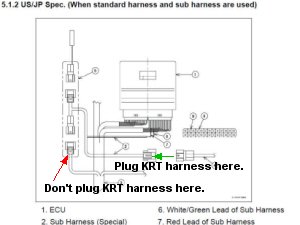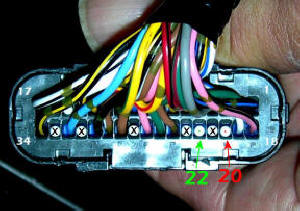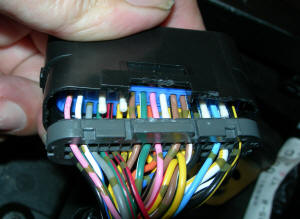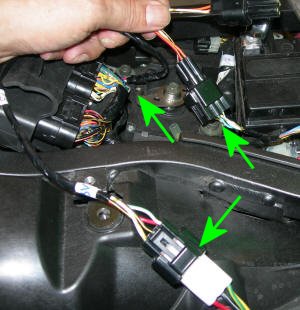| Kawasaki KRT Kit ECU - Fuel Injection Tuning - Marc Salvisberg | |
| Rough draft - | |
| Note! 1. the earliest 03/04 KRT software installs into "C:\Program Files\RACE" serial number "cdn-a469001". What is on our website is correct. Dec 2011. |
OK - this is the first start of the 06 zx6r tuning project that
we did. We'd done quite a few 03 and 04 600's a 636's, including a magazine project bike for Ed Sorbo at Roadracing World - but this was the first Kaw we'd done in a while and the first 05 / 06 that we'd started to do. The KRT kit FI Tuning manual is OK, and the software was improved from 03/04 but there was a small problem - Installing the kit ECU adapter harness on an 06 636... Seems the pdf manual has an ambiguous description of where the 2 wires that you need to insert into the bike's ecu actually connect. It shows a picture of something that doesn't quite look like a stock Kaw connector and wires.... Thanks Phil Seton (Seton Tuning UK site) and Shannon Woods at Attack Racing for helping and attempting to help sort the wire issue out.... |
 |
03/04 600rr and maybe others - Note: Dec 2011 on Triple Crown 04 practice bike There is a black 6 terminal connector with 5 wires used - It goes into the stock wiring harness on the right side of the battery. You aren't lucky, it's not the right connector for the KRT tuning cable. You will get "can't read ECU" error. You can identify a "street" stock wire harness as its got 2 smaller black rectangular 2 wire turn signal harness connectors, and 2 larger 2 (from memory) wire connectors, 1 black and 1 grey - tucked in back towards the rear of the bike. The KRT "tuning cable" will lug right into that connector, but it won't communicate. You need the KRT adapter harness as in the diagram to the left. |
 |
These
2 gray text boxes only for 03-04-05-06 zx6rr 600 and zx6r 636's. If you have a kit harness or a ZX10, skip this box - If you are using a kit ecu with a stock wire harness and the Kawasaki kit harness adapter - LOOK! This is the larger of the two stock wire harness connectors that plug into the ECU. The 2 wires on the kit wire harness adapter (the $30 part you had to buy so you could use your stock wire harness), plug into locations 20 and 22. The red wire to
pin location 20 #''s 20, 21, 22 and 23 are blanked with white pins in the stock harness from the factory. The wire location numbers are small and are 1 and 17 across the top and 34 and 18 across the bottom of the flat back connector plate in this picture. |
 |
Unclip the back flat connector housing, lift it up, remove #20 and #22 white plastic blanking pins. Replace the flat back and insert the 2 adapter harness wire into their proper holes. Look at the manual! With the connector oriented with the latch UP, the metal terminal must be oriented with the backbone of the terminal closest to the connector latch mechanism. I.E, the female pin receptacle "tube" of the terminal would be on the bottom of the terminal when oriented properly. This picture shows the black plastic connector housing with the latch mechanism oriented UP.
|
| Kawasaki kit KRT Computer Software The Kaw kit Tuning Software uses a "one time purchase" ECU to PC/Laptop Interface Cord, pn:26031-0240. It's not just a cable, it's a translator box / adapter wire harness to allow communication between your computer and the kit ecu. It's a serial cable device and seems to work well and reliably as long as you have the previously mentioned wires connected (or it will give you "Can't communicate" or "can't find" ecu error messages when you test the comm.) |
|
| Software install: Install the software: I suggest using the default C:\Program Files\RACE. On the 03/04 "RACE" software - The serial number is "cdn-a469001". (It's ok for me to publish that, according to the Pope). It's on the CD sleeve that came with the KRT software, many years ago. On the 05, 06 to prob 07 ish "FITool06Mk2", the serial number is still "cdn-a469001". For fun, you could try to find the magic serial number that unlocks the 5 degree ign adv limit. If there really are other serial numbers that work - I spent an evening trying different numbers. Here's some others that worked: JDN-B469001 KDN-A469010 KDN-A469001 KDN-A469100 KDN-B46900 If you are "reloading" the software for some reason, make sure you delete the directory RACE before you try to reinstall or the program's status bar will go about 1/4 way, wait a second and then disappear - with no error message. And it will not have reinstalled the program. The KRT software is finicky about conflicting "INI" files. (Dammit Jim, I'm a tuner, not a programmer!" If you are planning on deleting the RACE directory and reloading the install - make SURE you save any lower level WORK files that you may have done and want to save before you delete RACE. |
|
| Opening the program: Pretty sparse landscape! On the later versions of software - You'll have to first "pick" your machine. That sets up the program with your bike's parameters and some other things. Main menu: click on Set, Machineselect. If all went well in the install, you'll see a list of bikes. The 05 zx6rr(ZX600N) is used for the 05-06 zx6rr's and the 05-06 zx6r 636. You have to pick the correct machine, and then close and restart the program. (that is rather interesting procedure...) Early RACE versions of the software don't have Machine Select - just pic the "est" file and that's the 03/04 zx6r. |
|
| Next, you need to "Open" a calibration file.
It's a group of maps that offset the fuel, ignition, etc. values
from the semi-permanently programmed internal kit ECU maps. Main menu: click on "File/Open" If all default paths were accepted during install, you be able to choose a map that is in the WORK subdirectory of the selected machine's subdirectory (machineselect). |
|
| At first, you'll only get a
choice of "standard_data.est" or similar. This is the beginning table. It consists of a group of "zero" maps for the semi-permanent ECU tables that Denso flashed into the ECU. You could download the "standard_data.est" into the ECU and the bike would run the same as before. Choose the "standard_data.est" file. You will now be able to choose a single table in the next box. Pick any one of them for now or hit "cancel". Once you have gotten to this box, either way, you can check the PC to ECU communication. |
|
 |
Main menu: click on "Set/Monitor". That's so you can see the throttle position
and RPM, etc. while the engine is running. Turn on bike's ignition
and kill switch to "Run" and "start" Monitor. If you get some numeric values of temperatures and pressures. Great. That means your com Port is set correctly. If "Failed open RS232C port", then close Monitor and go to Main menu: Set/RS232 and try another port that you actually have, till you've tried all 8. If you are using a real serial port, they are usually 1 through 4. If you are attempting to use a USB to Serial converter, it's up to port 8 You could have cheated and looked a your computer hardware and seen what open com port your computer has...... If you choose the right port, the cable is connected properly, the bike's power is on and the kill switch is in "Run" position, you should have the Monitor showing current data about the bike. You can start the bike and watch the values change. Monitor doesn't have the world's quickest refresh rate, but unlike some aftermarket tuning "schemes", it seems to be very solid. Remember - the ECU has to run the bike AND communicate to the outside world, reliably. Our Teka 4usb refresh rate, for instance, will visually trace on the table, you "blipping" the throttle in neutral and that's quicker than anything else I've seen - but Denso's Monitor is perfectly fine for steady state testing.
Bummer is if you
are using the correct com port and you get a "Can't find ECU" error
message. That's all I can think of at the moment. Hopefully that's all you need. I happen to use a laptop to do KRT tuning. Older laptops tend to have
a serial port and newer laptops tend to only have USB. I try to not
use USB to Serial converters for the initial bike/computer setup as
there are potential and common special USB properties than can
prevent communication - even though all seems ok. |
| So, assuming that you've got your Monitor running (all you
really need to view is Throttle % and RPM). You can go up to the
main menu and select the items that you want displayed in Monitor.
Limit it to RPM and THrottle %. Go up to main menu: Select File/Menu or hit the "F1" key. Up pops a box named "Menu dialog". On the right, select "Multimap edit". Up pops another box that is mostly grayed out, "Multi Edit Mode" is selected and says "#1,#2,#3" and is supposed to say #4 is you have the right Windows font. You can't really select anything different here. When you click
"OK", you are temporarily locking "Compensation Map for Injection
No.1" and "Compensation Map for Injection No. 2" together.
Compensation inj table 1 is the fuel rate for cylinders 1&4 and Compensation inj
table 2 is cylinders 2&3. Magic! Something familiar is on the screen. On the top, the "Map" there's actually a bunch of overlaid lines at "0"
(it looks like 1 line) and on the
bottom, there's a familiar fuel injection "offset TABLE". Looks
similar to a Teka 4usb or PC table. Note! The Denso
software is set up to really NOT want you to accidentally leave the
2 Comp inj Maps linked. It will delink them whenever you change to
another type of map or when you exit the program. So - if you want
them linked (and you usually do when doing initial tuning, check
that "LABEL" displays "#1,#2" exclusively in the dropdown listbox. |
|
| Look at the fuel map: Now is the time to make sure that the rpm increments and
THrottle
position increments are what you want. If you don't do this now, you
can't do it later without discarding all tuning work you've already
done. (you only make that mistake once....) Double click on the rpm increment you want to change, change it. The program will force you to do increasing value steps, from left to right (as it should be). In the 600's, you probably use 2000 to 15000, and I think that the standard_data.est in the 05 600 was 3000 to 16000. If you raise the rev limit, maybe you'll have to use 3000 to 16000. Remember, these are REAL rpms, not the bike's TACH rpm. The stock tach is ~10% optimistic (as common with stock tachs). A relatively stock bike doesn't make power at a real 16000 rpm or is mechanically, in the valve train area, strong enough, so it's not recommended to raise the rev limit to 16000. In fact, in a stock engine, DON'T DO IT!!! You cannot add, what is called an extra "rpm breakpoint" in FI tuning language, you can only change the value of an existing breakpoint. I think that there's 12 rpm breakpoints (from memory). You can change the THrottle % breakpoints, too. I feel that 100, 80, 60, 50, 40, 30, 20, 15, 10, 7, 3, 0 are pretty comfortable and a little better than the "standard_data.est" values. I'm doing this from memory, so if you need another, I'd add 25% TH). Those are not quite as fine an increment as the THrottle % breakpoints that are used in our Teka 4usb module, but the 12 KRT THrottle breakpoints are better than a power commander's coarse THrottle breakpoints. You might notice that I capitalized "TH" in "THrottle". That's because eventually, I'll just type "TH" and you are supposed to know that means "THrottle". After you make the breakpoint values, Save the map as "MySTD_data,2k16k,myTH.est" or something that makes sense to you. It will, by default, save it in your selected "machineSelect" bike's WORK folder. |
|
| Ok - maybe it's time to actually tune. The tuning will be focused on using an EC997 dyno, as it's extremely easy to tune to Best Power. Probably easier to learn to tune to Best Power than to learn to work the Kaw, HRC and Suzuki Denso kit box software......... And now, how to win friends and influence people..... It's almost impossible, in less than most of a day, to tune to Best Power on a dealership level dyno as many race teams have in the USA. That's why you see kit ecu's with power commanders piggy-backed and Ignition modules piggy-backed to the piggy-backed fuel modules with piggybacked quick shift modules piggybacked on the other 2 piggybacked modules for fuel and ignition changes. The only reason for that is that they don't have the dyno capability to tune to Best Power. (one race team member, when discussing their dynojet dyno's tuning capabilities....("We don't just have a regular dynojet dyno." "What do you mean?" "Ours is built into the floor......" "Oh...I see.....") They religiously "tune to an af ratio" on a dynojet dyno at
racetracks and think that's the best it can be. (I guess that's why
they do it....). It takes 2 to 4 hours to tune the entire rpm / TH
band, fuel and ignition to Best Power using an EC997 dyne system
to close to 100% potential - Meaning it's tuned to Best Power
AND well enough to
be a streetbike, with smooth lowend cruise, etc... Takes about 1/2
hour - 45 minutes of running to start from scratch and do a
"racetrack" quality job. A "Racetrack" job is making the bike idle
and take throttle, then tuning any horrible spots, then tuning the
all the throttle positions and rpms that the rider will use on the
track. There's only one big (successful) team team knows that "tuning to an af ratio" is not a goal....... |
|
| To be continued May 03 2006 | |
| 03-05 FITool04Mk |
zipped disc 03-05, zx6rr, zx10r (treat as a disc to install) |
| Serial numbers that work | JDN-B469001 KDN-A469010 KDN-A469001 KDN-A469100 KDN-B469001 |